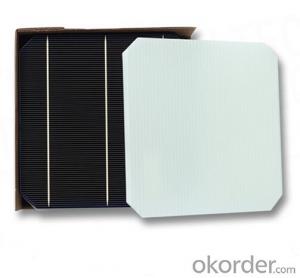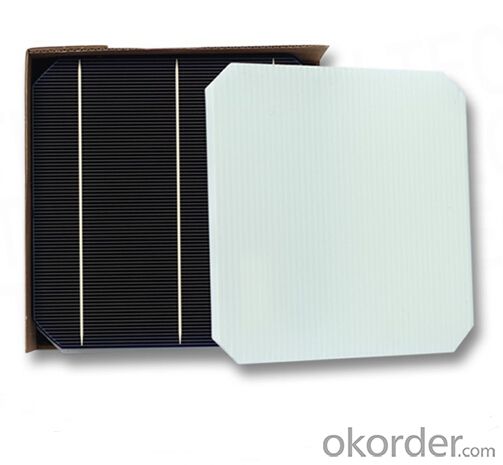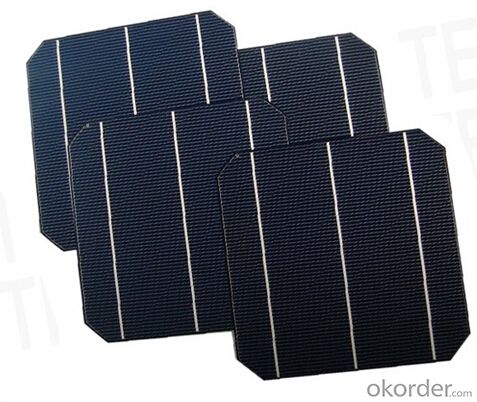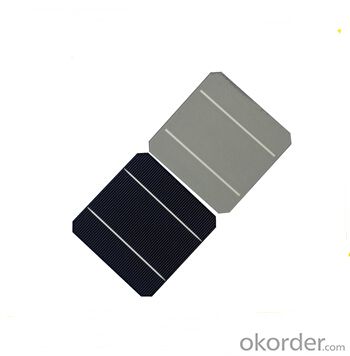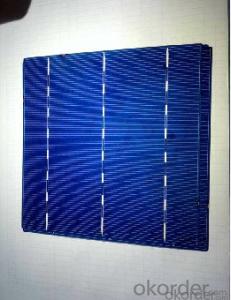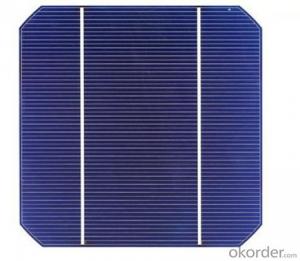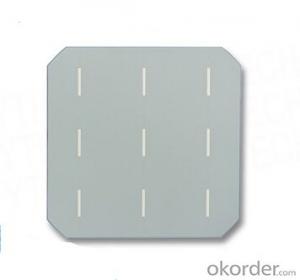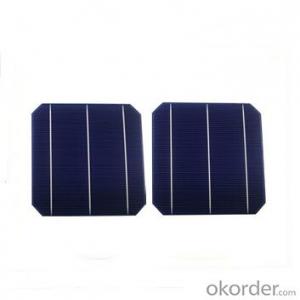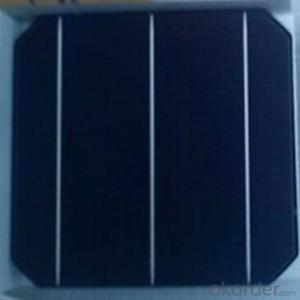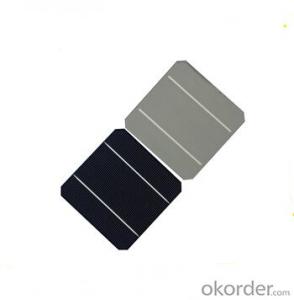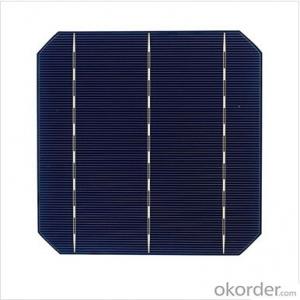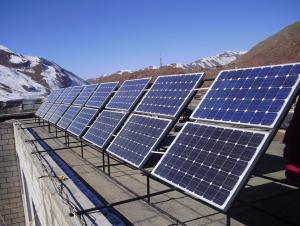Bio Solar Cells - Monocrystalline Solar Cells A Grade 18.2%
- Loading Port:
- Shanghai
- Payment Terms:
- TT OR LC
- Min Order Qty:
- 5000 pc
- Supply Capability:
- 800000 pc/month
OKorder Service Pledge
OKorder Financial Service
You Might Also Like
Brief Introduction of Solar Cells
A solar cell, is an electrical device that converts the energy of light directly into electricity by the photovoltaic effect, which is a physical and chemical phenomenon. It is a form of photoelectric cell, defined as a device whose electrical characteristics, such as current, voltage, or resistance, vary when exposed to light. Solar cells are the building blocks of photovoltaic modules, otherwise known as solar panels.
Advantage of Monocrystalline Solar Cells
1. Tire-1 Solar Cells’ Manufacturer Quality Guarantee. With a complete and sophisticated quality government system, our Quality Management have arrived world’s leading place. Customer can receive Tire-1 Cells Maker’s Quality Standard Products.
2. Trusted Warranty. We can supply trusted after-sales service to our customer. If our cells are found not in conformity to the specification of manufacturer, or should the inspected quantity found in shortage, or should the packing found damaged, the buyer has the right to claim to the seller. The claim, if any, should be presented to seller within 30 days after cargo's arrival date to the port, together with related inspection report and photos issued and provided by a reputable independent surveyor such as SGS.
3. World’s Leading Manufacturer Equipment. We imported the newest and leading production equipment from abroad. Advanced equipment can guarantee the stable quality of cells. Auto production line can also save labor cost which will further cut our production cost.
Specifications of Polycrystalline Solar Cells
Format : 156 mm × 156 mm ± 0.5 mm
Thickness: 210 μm ±40 μm
Front (-) : 1.5mm bus bars (silver),blue anti-reflection coating (silicon nitride)
Back (+) : 2.5mm wide soldering pads (silver) back surface field (aluminium)
Efficiency (%) Pmpp (W) Umpp (V) Impp (A) Uoc (V) Isc (A) |
18.20% 4.43 0.536 8.263 0.634 8.712 |
18.00% 4.38 0.535 - 8.188 0.633 8.701 |
17.80% - 4.33 0.534 - -8.112 ---0.632 ----8.652 |
17.60% 4.28 0.533 8.036 0.631 8.641 |
17.40% 4.23 0.529 8.005 0.630 8.591 |
17.20% 4.19 0.525 7.973 0.627 8.542 |
17.00% 4.14 0.522 7.926 0.624 8.495 |
16.80% 4.09 0.518 7.893 0.620 8.452 |
16.60% 4.04 0.515 7.844 0.617 8.410 |
16.40% 3.99 0.514 7.765 0.616 8.373 |
16.20% 3.94 0.511 7.715 0.615 8.317 |
16.00% 3.89 0.509 7.650 0.613 8.251 |
Usage of Monocrystalline Solar Cells
Solar cells are often electrically connected and encapsulated as a module. Photovoltaic modules often have a sheet of glass on the front (sun up) side, allowing light to pass while protecting the semiconductor wafers from abrasion and impact due to wind-driven debris, rain, hail, etc. Solar cells are also usually connected in series in modules, creating an additive voltage. Connecting cells in parallel will yield a higher current; our solar cells have passed IEC Certification. With high and stable quality, our cells can greatly improve the performance of Solar Modules.
Applications of Monocrystalline Solar Cells
Assemblies of photovoltaic cells are used to make solar modules which generate electrical power from sunlight, as distinguished from a "solar module" or "solar panel". A solar array generates solar power using solar energy.
Packaging & Delivery of Monocrystalline Solar Cells
Carton Box Package and Deliver by air. It should be noticed that it should be avoid of water, sunshine and moist.
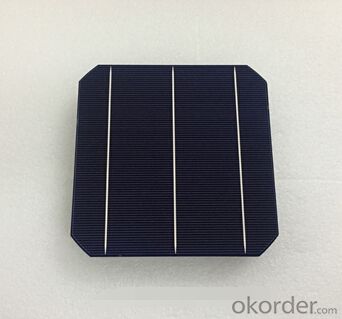
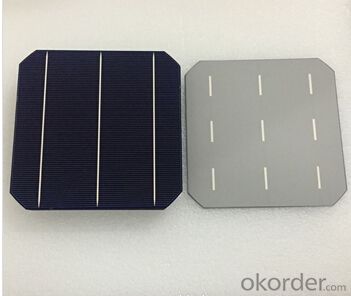
FAQ
We have organized several common questions for our clients,may help you sincerely:
①What price for each watt?
It depends on the efficiency of the solar cell, quantity, delivery date and payment terms.
②How long can we receive the product after purchase?
In the purchase of product within three working days, We will arrange the factory delivery as soon as possible. The pecific time of receiving is related to the state and position of customers.Commonly 7 to 10 working days can be served.
③Can you provide the peripheral products of the solar panels, such as the battery, controller, and inverter? If so, can you tell me how do they match each other?
Yes, we can, we have two companies for solar region, one is CNBM International, the other is CNBM engineering Co.
We can provide you not only the solar module but also the off grid solar system, we can also provide you service with on grid plant.
④What is your warranty of solar cell?
Our product can promise lower than 0.3% open box crack, we support claim after opening the box if it has crackm color difference or sth, the buyer should give pictures immediately, we can not accept the claim after the solar cell has assembled to solar panel.
• Timeliness of delivery
• ⑤How do you pack your products?
We have rich experience on how to pack the solar cell to make sure the safety on shipment, we could use wooden box or pallet as buyer's preference.
⑥ Can you do OEM for us?
Yes, we can.
- Q: What materials are commonly used in solar cells?
- Some common materials used in solar cells include silicon, cadmium telluride, and copper indium gallium selenide.
- Q: What is the role of solar cell inverters in grid-tied systems?
- The role of solar cell inverters in grid-tied systems is to convert the direct current (DC) electricity generated by the solar panels into alternating current (AC) electricity that can be used by the electrical grid. Additionally, they ensure that the solar system operates safely and efficiently by monitoring the grid voltage and frequency, synchronizing with the grid, and providing protection against power fluctuations or interruptions.
- Q: How do solar cells impact energy independence?
- Solar cells impact energy independence by providing a renewable and sustainable source of electricity. They reduce dependence on fossil fuels and foreign oil, allowing countries and individuals to generate their own clean energy. Solar cells can be installed on rooftops, in remote areas, or even integrated into buildings, enabling individuals and communities to become self-sufficient and less reliant on centralized power grids. Ultimately, solar cells contribute to reducing carbon emissions and promoting long-term energy independence.
- Q: What is the impact of bird droppings on solar cell performance?
- Bird droppings can significantly impact solar cell performance by reducing the amount of sunlight reaching the surface of the cells. The droppings can act as a physical barrier, blocking sunlight and reducing the efficiency of the solar cells in converting sunlight into electricity. Additionally, the chemical composition of bird droppings can cause corrosion and damage to the surface of the cells, further degrading their performance over time. Regular cleaning and maintenance are essential to ensure optimal solar cell efficiency and prevent any long-term negative impact from bird droppings.
- Q: How do solar cells perform in areas with high levels of air pollution and dust?
- Solar cells perform less efficiently in areas with high levels of air pollution and dust. The particles in the air can block sunlight from reaching the solar cells, reducing their ability to convert sunlight into electricity. This can result in a decrease in overall energy production and efficiency of the solar panels. Regular cleaning and maintenance of the solar cells can help mitigate the negative impact of air pollution and dust on their performance.
- Q: How are solar cells connected in a photovoltaic system?
- Solar cells are connected in a photovoltaic system through series and parallel connections to form strings and modules, which are then connected to inverters to convert the generated DC electricity into AC electricity for use in homes or businesses.
- Q: What is the lifespan of solar cells?
- The lifespan of solar cells typically varies between 25 to 30 years, although some high-quality panels can last up to 40 years with proper maintenance and care.
- Q: Can solar cells be used in underwater vehicles or submarines?
- Yes, solar cells can be used in underwater vehicles or submarines. However, they have certain limitations due to the reduced availability of sunlight underwater. To overcome this challenge, the solar cells used in these vehicles are usually highly efficient and designed to operate even in low-light conditions. Additionally, the surface area of solar panels may need to be increased to compensate for the reduced sunlight intensity.
- Q: What is the impact of leaf litter on solar cell performance?
- Leaf litter can have a negative impact on solar cell performance as it can block sunlight from reaching the cells, reducing their efficiency. Additionally, if the litter accumulates and covers the cells, it can hinder their ability to convert light into electricity. Regular cleaning and maintenance are essential to ensure optimal solar cell performance.
- Q: Can solar cells be used for powering remote research stations?
- Yes, solar cells can be used for powering remote research stations. Solar cells, also known as photovoltaic cells, convert sunlight into electricity, making them an ideal choice for locations where grid connections are impractical or non-existent. By harnessing the power of the sun, solar cells can provide a reliable and sustainable source of energy for remote research stations, ensuring continuous power supply for various scientific activities and equipment.
Send your message to us
Bio Solar Cells - Monocrystalline Solar Cells A Grade 18.2%
- Loading Port:
- Shanghai
- Payment Terms:
- TT OR LC
- Min Order Qty:
- 5000 pc
- Supply Capability:
- 800000 pc/month
OKorder Service Pledge
OKorder Financial Service
Similar products
Hot products
Hot Searches
Related keywords
